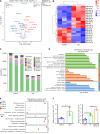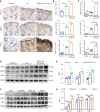MicroRNA-122-5p is upregulated in diabetic foot ulcers and decelerates the transition from the inflammatory to the proliferative stage
- PMID: 40236859
- PMCID: PMC11947911
- DOI: 10.4239/wjd.v16.i4.100113
MicroRNA-122-5p is upregulated in diabetic foot ulcers and decelerates the transition from the inflammatory to the proliferative stage
Abstract
Background: Shifting from the inflammatory to the proliferative phase represents a pivotal step during managing diabetic foot ulcers (DFUs); however, existing medical interventions remain insufficient. MicroRNAs (miRs) highlight notable capacity for accelerating the repair process of DFUs. Previous research has demonstrated which miR-122-5p regulates matrix metalloproteinases under diabetic conditions, thereby influencing extracellular matrix dynamics.
Aim: To investigate the impact of miR-122-5p on the transition from the inflammatory to the proliferative stage in DFU.
Methods: Analysis for miR-122-5p expression in skin tissues from diabetic ulcer patients and mice was analyzed using quantitative real-time polymerase chain reaction (qRT-PCR). A diabetic wound healing model induced by streptozotocin was used, with mice receiving intradermal injections of adeno-associated virus -DJ encoding empty vector or miR-122. Skin tissues were retrieved at 3, 7, and 14 days after injury for gene expression analysis, histology, immunohistochemistry, and network studies. The study explored miR-122-5p's role in macrophage-fibroblast interactions and its effect on transitioning from inflammation to proliferation in DFU healing.
Results: High-throughput sequencing revealed miR-122-5p as crucial for DFU healing. qRT-PCR showed significant upregulation of miR-122-5p within diabetic skin among DFU individuals and mice. Western blot, along with immunohistochemical and enzyme-linked immunosorbent assay, demonstrating the upregulation of inflammatory mediators (hypoxia inducible factor-1α, matrix metalloproteinase 9, tumor necrosis factor-α) and reduced fibrosis markers (fibronectin 1, α-smooth muscle actin) by targeting vascular endothelial growth factor. Fluorescence in situ hybridization indicated its expression localized to epidermal keratinocytes and fibroblasts in diabetic mice. Immunofluorescence revealed enhanced increased presence of M1 macrophages and reduced M2 polarization, highlighting its role in inflammation. MiR-122-5p elevated inflammatory cytokine levels while suppressing fibrotic activity from fibroblasts exposed to macrophage-derived media, highlighting its pivotal role in regulating DFU healing.
Conclusion: MiR-122-5p impedes cutaneous healing of diabetic mice via enhancing inflammation and inhibiting fibrosis, offering insights into miR roles in human skin wound repair.
Keywords: Diabetic foot ulcer; Fibrosis; Inflammation; MicroRNA-122-5p; Wound healing.
©The Author(s) 2025. Published by Baishideng Publishing Group Inc. All rights reserved.
Conflict of interest statement
Conflict-of-interest statement: The authors declare that they have no conflict of interest.
Figures





Similar articles
-
Upregulation of miR-155-5p impaired ginsenoside Rg1-mediated wound healing in diabetic foot ulcers by targeting E2F2/CDCA7L signaling : Rg1 improves DFU wound healing via inhibiting miR-155-5p.Mol Biol Rep. 2025 May 30;52(1):523. doi: 10.1007/s11033-025-10600-5. Mol Biol Rep. 2025. PMID: 40445390
-
MicroRNA miR-145-5p Inhibits Cutaneous Wound Healing by Targeting PDGFD in Diabetic Foot Ulcer.Biochem Genet. 2024 Aug;62(4):2437-2454. doi: 10.1007/s10528-023-10551-1. Epub 2023 Nov 11. Biochem Genet. 2024. PMID: 37950842
-
MicroRNA-145-5p regulates fibrotic features of recessive dystrophic epidermolysis bullosa skin fibroblasts.Br J Dermatol. 2019 Nov;181(5):1017-1027. doi: 10.1111/bjd.17840. Epub 2019 Oct 20. Br J Dermatol. 2019. PMID: 30816994
-
New Horizons of Macrophage Immunomodulation in the Healing of Diabetic Foot Ulcers.Pharmaceutics. 2022 Sep 27;14(10):2065. doi: 10.3390/pharmaceutics14102065. Pharmaceutics. 2022. PMID: 36297499 Free PMC article. Review.
-
Electrospinning strategies targeting fibroblast for wound healing of diabetic foot ulcers.APL Bioeng. 2025 Feb 25;9(1):011501. doi: 10.1063/5.0235412. eCollection 2025 Mar. APL Bioeng. 2025. PMID: 40027546 Free PMC article. Review.
References
-
- Armstrong DG, Boulton AJM, Bus SA. Diabetic Foot Ulcers and Their Recurrence. N Engl J Med. 2017;376:2367–2375. - PubMed
-
- Zhang S, Liu H, Li W, Liu X, Ma L, Zhao T, Ding Q, Ding C, Liu W. Polysaccharide-based hydrogel promotes skin wound repair and research progress on its repair mechanism. Int J Biol Macromol. 2023;248:125949. - PubMed
LinkOut - more resources
Full Text Sources

